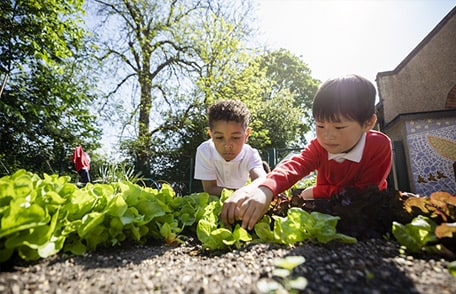Success Stories in Lead Poisoning Prevention

Learn more about how CDC’s National Center for Environmental Health (NCEH) and the Agency for Toxic Substances and Disease Registry (ATSDR) work to monitor and reduce children’s exposure to lead in the United States.
Lead is a naturally occurring metal that can cause negative health effects. It can be found in the places where we live, learn, work, and play. Children can be exposed to lead by breathing or swallowing lead through lead-contaminated dust, water, paint chips, toys, soil, foods, and traditional home remedies. Young children tend to put their hands, which may be contaminated with lead dust, into their mouths.
Exposure to lead can cause high blood pressure, joint and abdomen pain, kidney damage, and death. In children, health effects of lead poisoning may include damage to the brain and nervous system, slowed growth and development, learning and behavior problems, and hearing and speech problems. These effects can result in lower IQ, decreased ability to pay attention, and underperformance in school.
All children can be exposed to lead. However, children who are from low-income households, certain racial and ethnic minorities, immigrants and refugees, and those who live in housing built before 1978 are at the greatest risk of lead exposure. Lead was banned from residential house paint in the United States in 1978. Houses in low-income areas, many of which have homes built before 1978, are more likely to contain lead-based paint and have pipes, faucets, and plumbing fixtures containing lead.
Lead in paint, soil, air, or water is invisible to the naked eye and has no smell. Most children with lead in their blood show no immediate symptoms. A blood test is the best way to determine if a child has been exposed to lead.
CDC and the Agency for Toxic Substances and Disease Registry (ATSDR) have dedicated various efforts to monitor and reduce lead exposure in children. CDC’s Childhood Lead Poisoning Prevention Program and ATSDR’s soilSHOP program provide communities, parents, and healthcare providers with resources to protect children from lead exposure.
Advancing Childhood Lead Poisoning Prevention

If you think your child has been exposed to lead, contact their healthcare provider to help you determine whether to have your child tested for lead.
CDC’s Childhood Lead Poisoning Prevention Program (CLPPP) is dedicated to addressing childhood lead poisoning as a public health problem. In 2021, the program celebrated 30 years of funding state and local childhood lead poisoning prevention programs across the United States.
In 2012, CDC introduced a blood lead reference value (BLRV) to identify children with higher levels of lead in their blood compared to most children in the United States. Periodically, CDC analyzes blood lead data from the National Health and Nutrition Examination Survey (NHANES) to determine whether the reference value should be updated. In 2021, CDC updated the BLRV from 5 μg/dL to 3.5 μg/dL. The reference value helps guide healthcare providers as they evaluate blood lead levels in children and recommend actions to reduce lead exposure and connect children to needed services.
CLPPP also works to reduce health disparities. As part of a new pilot program, nine funded recipients will provide data periodically through 2024 on how many children enrolled in Medicaid are tested for lead poisoning and what steps the funded recipients are taking to increase testing. “The program’s goal is to increase testing, particularly in children who receive Medicaid,” says CLPPP’s program development, communication, and evaluation lead Perri Ruckart.
Promoting Safer Places for Gardening and Outdoor Play

soilSHOP events provide free soil screening and health education to help community members learn if their soil is contaminated with lead and learn ways to reduce exposures.
Photo credit: Lauren Bishop (CDC Photographer)
Lead is commonly found in soil in urban areas or areas with legacy contamination from former lead smelters, mines, or other industrial sites. In 2018, ATSDR introduced the Soil, Screening, Health, Outreach, and Partnership (soilSHOP) initiative to help communities have safer gardening and outdoor play environments. The program provides community members with free lead screenings of soil gathered from their gardens or outdoor play areas.
soilSHOP events support lead poisoning prevention through activities like soil screenings and partnerships with local organizations that provide health education and community outreach. soilSHOP events have been held in more than 20 states to help community members learn if their soil is contaminated with lead and find ways to reduce exposures.
Leann Bing, an environmental health scientist in ATSDR’s Office of Community Health Hazard Assessment, explains that children can more easily be exposed to lead from bare, uncovered soil. Community members can use mulch and other sand-like materials to cover the bare spots and reduce exposure risk.
Bing also describes how individuals can protect themselves and their families by knowing where lead is commonly found and how it can affect health. “In general, just be aware there could be lead in soil. Make sure small children aren’t playing in the bare spots in the yard, and when they come inside the house, make sure they take off their shoes and clean their hands,” Bing says.
Preventing Lead Exposure
Children can be exposed to lead in their home or through their usual play environments. Families can take steps to prevent lead exposure by checking their homes (if they were built before 1978) for chipped paint; testing soil in their yard for lead; and making sure other products such as children’s toys, candies, food, and traditional home remedies do not contain lead. Being aware of sources of lead exposure and protecting children from exposure is important for lifelong good health.
If you think your child has been exposed to lead, contact your child’s healthcare provider. They can help you determine if your child needs to be tested; find ways to reduce exposure to lead; and recommend health services.